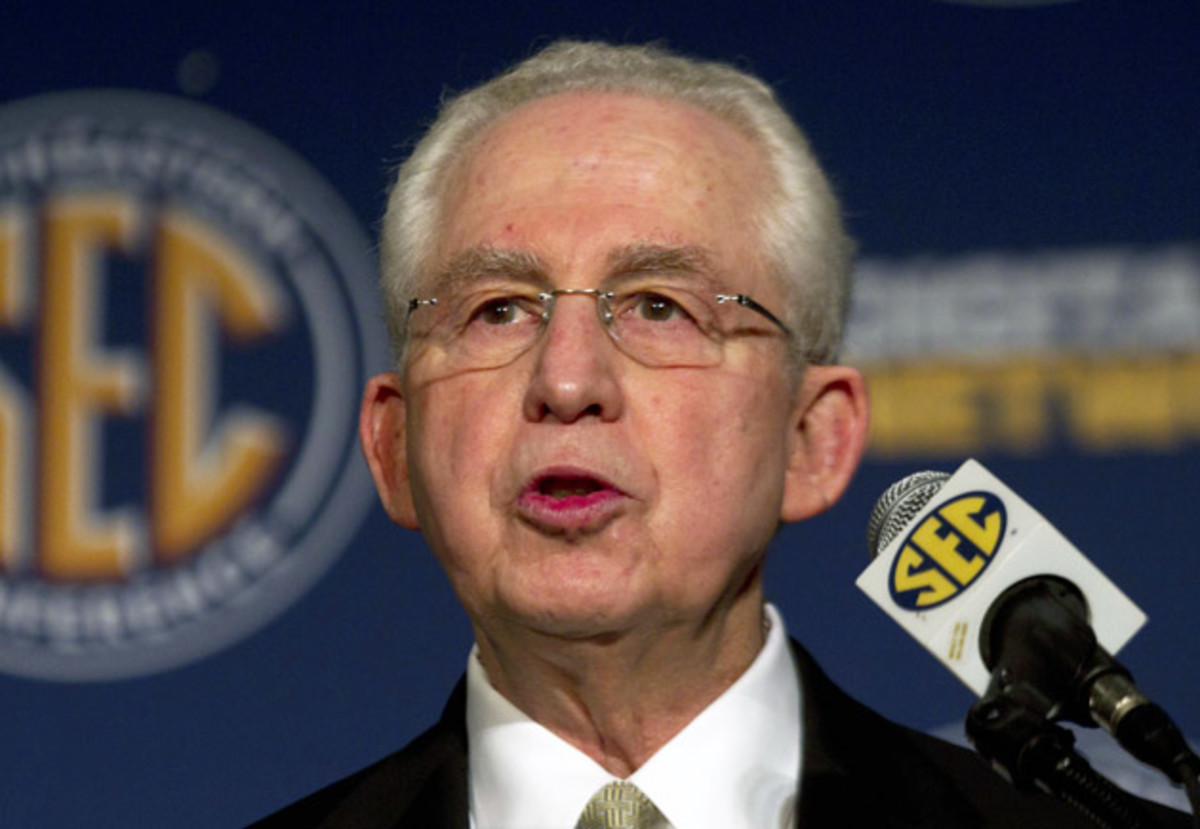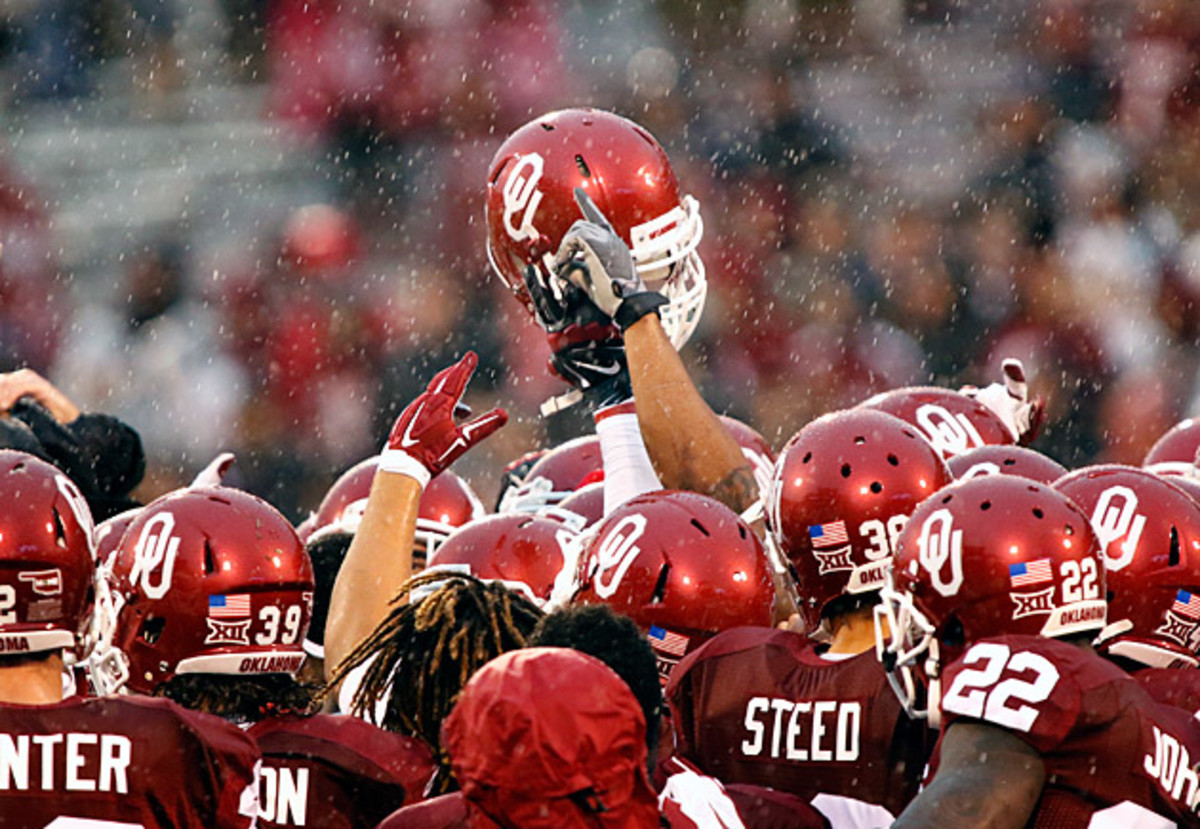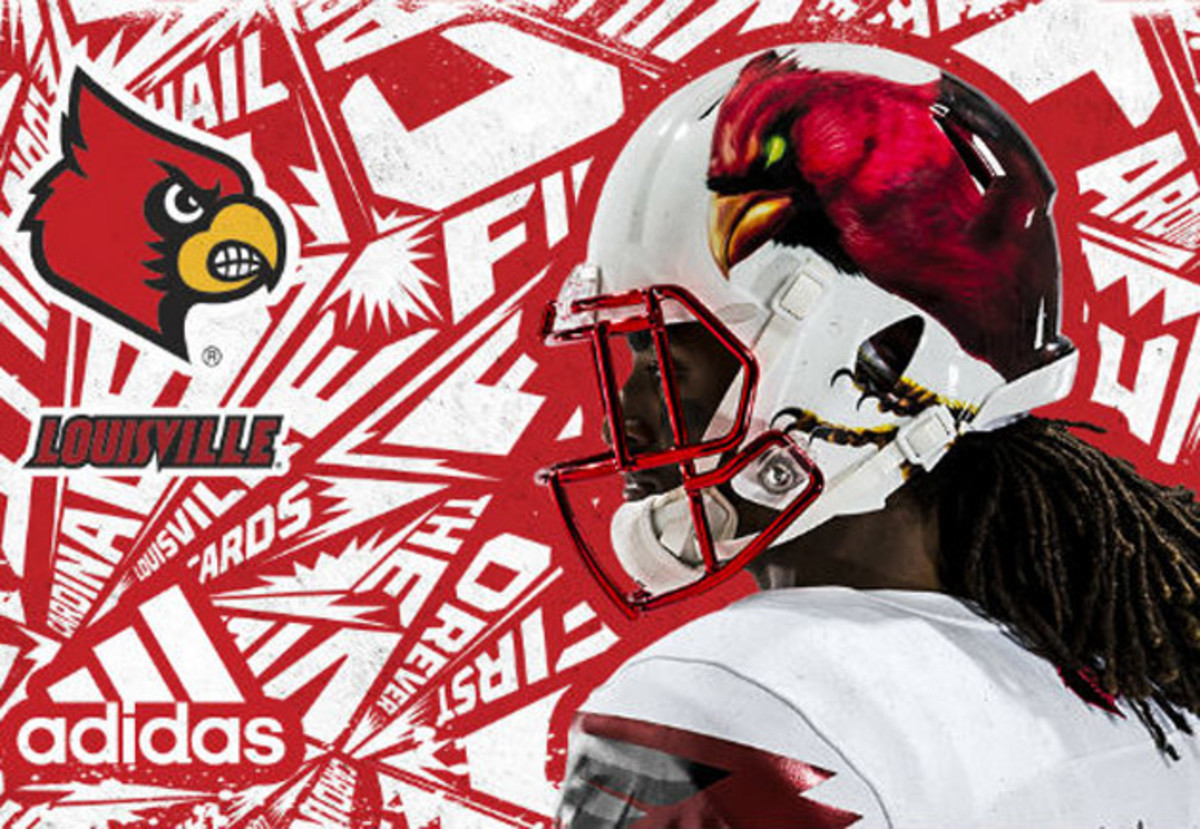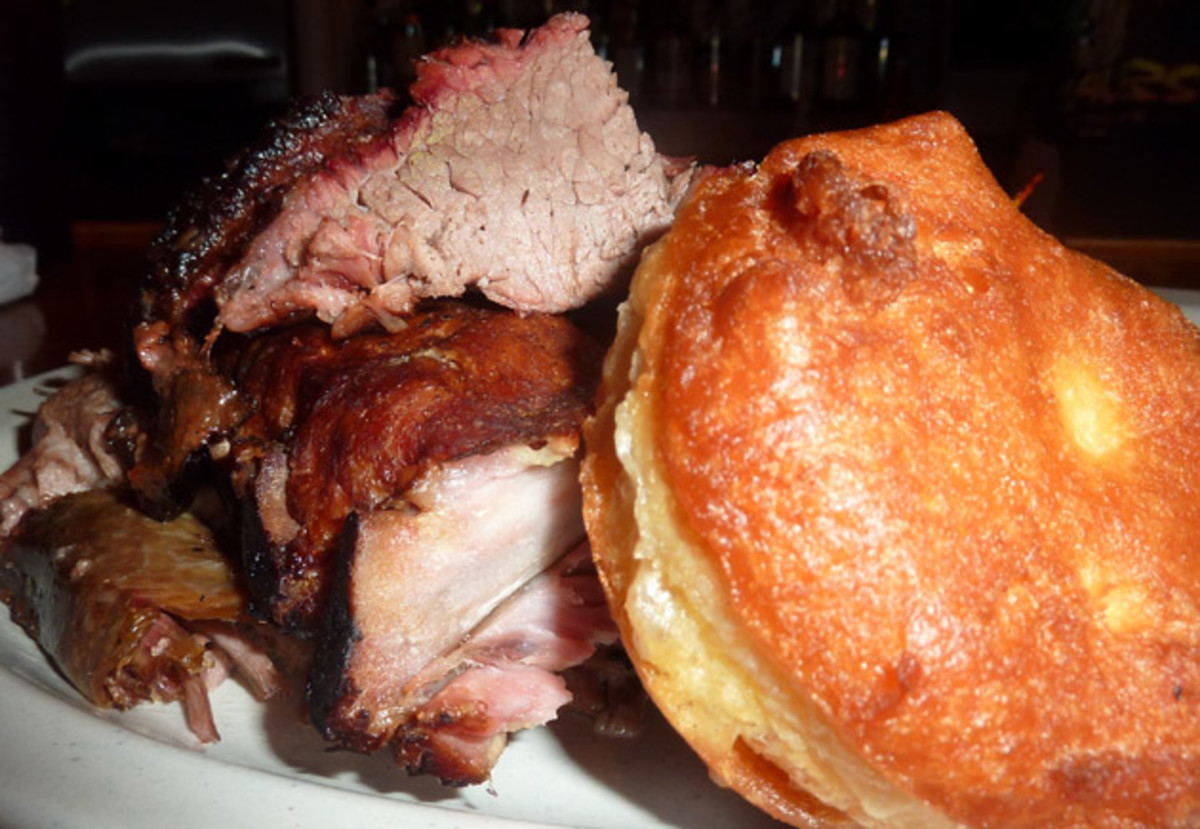Mike Slive's legacy on the SEC and college football; Punt, Pass & Pork

ATLANTA—In the middle of the room at Mike Slive’s 74th birthday and retirement party Friday was a board covered with photos. One shot showed Slive as a senior lacrosse player at Dartmouth in 1962. Another shot showed Slive as the athletic director at Cornell in the early 1980s. Another showed Slive, two years into his job as the SEC commissioner, talking to the 2004 Auburn football team as the Tigers sat in their locker room after beating Tennessee for the SEC title. Auburn had a 12-0 record and no chance to win the national championship.
The party was winding down, and the stragglers had gathered around the board with the guest of honor. Some of the biggest muckety-mucks in college sports had come to fete Slive and wife Liz after the conclusion of one of the most influential careers in the history of the business. Slive had received an NCAA championship trophy from NCAA executive vice president Mark Lewis. The ADs had made Slive a championship ring. New SEC commissioner Greg Sankey had given Slive a framed copy of Rudyard Kipling’s “If” and a golden ticket that would get the Slives into any SEC sporting event. “The one problem we have is our athletic directors are a little tight on parking passes,” Sankey cracked. After Slive had said a tearful goodbye to the SEC, some guests had headed to waiting private jets. Others had lingered for one more handshake. Eventually, Slive ended up at that board looking at that Auburn photo. “What was I supposed to say to them?” Slive asked a group that had huddled to hear the stories behind the photos. Asked if that moment set in motion the events that would lead to Ohio State winning two games in January to capture the national title, Slive nodded. “That,” he said, “was the beginning of the playoff.”
How one morning talk helped key Ohio State's title run; Punt, Pass & Pork
The list of Slive’s professional accomplishments is long, but the College Football Playoff will stand atop them all. When he addressed those Auburn players in 2004, Slive had no idea his league was only 25 months away from beginning a streak of winning seven consecutive national titles. Slive only knew that he had to come up with a way to ensure an undefeated team from his conference would never get shut out of the national title chase again. In choosing this path, he went against decades of tradition and against the rest of the sport’s power structure. When he first proposed a version of the playoff at a BCS meeting in ’08, only ACC commissioner John Swofford stood beside him. It was one of the few times that Slive hadn’t built an ironclad consensus behind the scenes before going public with an idea. The Big Ten and Pac-10 were not going along with the plan, but the Big 12 and Big East should have been. In ’11, an 11-1 Big 12 champ that probably would have been given a shot at the national title had Slive’s plan been approved had to watch as two SEC teams played for the BCS crown. Meanwhile, the Big East, which enjoyed protected status as an automatic-qualifying conference in the BCS structure, was eventually ripped to shreds by realignment.
Slive never said, “I told you so.” He didn’t have to. By then, it was obvious to everyone that Slive had been several steps ahead. That was one of Slive’s gifts. He could see further than many of his colleagues. At SEC Media Days in 2011, Slive issued a four-point plan he hoped would help reform major college athletics. “We don't have the luxury of acting as if it's business as usual,” Slive said that day. “Intercollegiate athletics has lost the benefit of the doubt.” What he meant was, “If we don’t start sharing some more of this money with the athletes, we’re going to get sued out the wazoo.” O’Bannon v. NCAA was already filed at the time, but most of the other cases that currently threaten the business model of major college sports* had not been. Leaders of other conferences didn’t listen. In the following year, a proposed $2,000-a-year stipend for athletes got shot down by less wealthy leagues whose leaders lacked the foresight to see the price tag would only rise.

*Whether that business model should be defended or altered more radically is another debate for another day. It was Slive’s job to make sure business ran smoothly, and he anticipated a lot of the challenges and tried to respond before many of his peers did.
Through his own research and thanks to some wise counsel, Slive also set up the SEC for financial security for at least the next decade. He could have agreed to set up a cable channel in 2009 when the league renewed its deals with ESPN and CBS, but he and television consultant Chuck Gerber elected to wait. The Big Ten had just launched its network. That channel was the brainchild of commissioner Jim Delany, who has been Slive’s only equal in terms of power and influence in this generation of college sports. The SEC could have followed suit, but Slive and Gerber knew they had signed that deal at the nadir of the U.S. economy. Holding the network piece back would allow them to make far more on rights they had basically already sold to ESPN. So, after adding Texas A&M and Missouri in ’11 and increasing the league’s footprint by more than 10 million cable homes, Slive issued the go-ahead for the network. This year, after only 10 months of SEC Network operation, the SEC split $455 million among its 14 schools. At Slive’s first spring meeting as commissioner in ’03, the SEC split $101.9 million among 12.
Wild success of SEC Network creating Titanic Two of conference finances
Slive intends to enjoy retirement. For the first time in a while, he won’t spend his anniversary at SEC Media Days. He and Liz will have No. 47 all to themselves. Slive spent his final year in office fighting prostate cancer, but said Friday that his oncologist has pronounced him “boring.” That may be an insult coming from anyone else, but it’s a blessing coming from someone in that particular line of work.
Sankey will have to be the one who sees the future now. He and whoever replaces Delany—who is a likely candidate to retire once the Big Ten’s next TV deal gets locked down—will probably be the ones who lead college sports for the next 15 years. Slive’s tenure was defined by the debate over the playoff, by one big lawsuit and by cable subscriber fees. Sankey’s tenure could well be defined by the debate over the size of the playoff, by more lawsuits and by how conferences keep the money flowing in if the cable bubble bursts. Friday night, Sankey looked back at his predecessor and shared the most common advice he has been given.
“Don’t screw it up,” he said.
A random ranking
Perhaps the only redeeming quality of the 2001 film Joe Dirt was the fireworks stand scene. This certainly wasn’t enough to merit a sequel, but we’re getting one anyway. This is the one week a year when many of us will go to our local hastily assembled fireworks stands and ask for Whisker Biscuits, Husker Dus and Husker Don’ts. This time, come armed with actual firework names. Here are the top five.
1. Grounds For Divorce
This is a combo pack. It is aptly named because it costs $1,499.99. But honey, it’s a $1,750 value.
2. Redneck Ruckus
For those of us who want to be informed pyrotechnic consumers, there are YouTube clips that show nearly every offering from the major fireworks companies. Here is the Ruckus in all its glory.
3. St. Elmo’s Fire
Video of this firework does exist on the web. I just happen to prefer this St. Elmo’s Fire-related video.
4. Plumber’s Crackle
Far more spectacular than the name suggests.
5. That’s Your Problem
What you’ll be telling your neighbors after your glorious fireworks display sends their yippy teacup dogs into a frenzy.
[pagebreak]

First-and-10
1. Oklahoma president David Boren expanded on his wish for the Big 12 to expand in a statement sent Friday to student paper The Oklahoma Daily.
“Commissioner [Bob] Bowlsby said publicly yesterday, as reported in The Daily Oklahoman, that our television contracts are written to expand proportionally if we add additional schools. In other words, the pie gets proportionally larger if it is cut 12 ways instead of 10. There could be some slight loss of revenue from bowl games and other sources, but if the conference carefully selects additional members, based upon their media markets and fan base support, the amount should increase rather than decrease. We should; however, be very selective. I do not favor adding two more members unless they meet very high criteria. When we look at football playoffs and our conference is bumping up against conferences with 12 or 14 members, I believe that we are psychologically disadvantaged because we are a smaller conference.”
When the DSM-6 comes out, the editors can add Membership Envy. That is Boren’s diagnosis—even though he is in the minority of Big 12 presidents. On Friday Bowlsby said on Paul Finebaum's radio show that he thinks about a third of the presidents favor expansion at the moment. Bowlsby did allow that a few might be on the fence, and in a 10-school league, it doesn’t take many presidents swinging the opposite direction to change the conference’s stance.
2. One of the most interesting aspects of Boren’s comments last Wednesday at an Oklahoma Board of Regents meeting was his reveal that the Big 12’s media rights deals are structured so they would increase by equal shares if the league decided to expand. That wouldn’t keep the existing schools from having to take a pay cut—because they’d still have to split bowl and playoff money more ways—but it goes a long way toward making expansion a viable option.
What’s interesting is that in previous discussions no one from the Big 12 has mentioned this clause. In fact, the primary argument against expansion was there weren’t two schools out there that had enough juice to justify ESPN and FOX paying 20% more. But what Boren said Wednesday—and Bowlsby confirmed Thursday—means that argument wasn’t entirely genuine. Expansion was always an easier possibility than people who weren’t privy to the league’s TV deal thought.
3. I still don’t understand why 12 is any better than 10—especially when the two schools that could be added come from a group deemed unworthy of joining Power Five leagues during the last round of realignment. Once the conference title game rule gets taken away, the Big 12 will be able to stage one with 10 schools. That takes away any need to grow to 12. The argument that having 12 provides more security doesn’t hold water; the 10 Big 12 schools signed a Grant of Rights that essentially makes them worthless to other conferences until after the Big 12’s current media rights deals expire.
The only reason to expand is territory acquisition—simply increasing the size of the conference footprint. That makes a lot of sense for leagues with cable channels. In the above section about Slive, I mentioned the addition of 10 million cable homes. Here’s how the math on that works. The SEC Network receives 25 cents a month for subscribers outside the conference footprint and $1.40 a month for subscribers inside the footprint. We’ll ignore for a moment that those additional homes likely also drive up the in-footprint rate. That means those cable/satellite homes in Texas and Missouri are worth an additional $11.5 million a month to ESPN and the SEC. This also explains why Maryland and Rutgers were so important to the Big Ten.
But the Big 12 doesn’t have a conference network. It can’t because the schools have sold the rights to what would be on that channel to competing networks. Most famously, Texas sold its third-tier rights to ESPN to create the Longhorn Network. And that’s what makes one thing Boren said Wednesday really interesting. “The elephant in the room remains the network south of us that has struggled and has in a way as long as it’s there,” Boren told The Oklahoman. “And we have done quite well with our network and if anything ever changed, it has value to it which we see. But someday, maybe we’ll get past that other problem as well. It’s a problem.”
Evaluating candidates for possible (albeit unlikely) Big 12 expansion
By this same token, this would also make Oklahoma’s deal with FOX and Kansas’s deal with ESPN a problem, but the Longhorn Network is the most lucrative and most controversial of those deals. And if somehow the Big 12’s members decided to walk back their third-tier deals and pool those rights to form a network, then adding two (or four) more schools would make an awful lot of sense. But that’s a huge “if.”
4. An arrest report for Ole Miss offensive tackle Laremy Tunsil will be made available Monday, but in the meantime Ole Miss officials and Tunsil’s stepfather are telling conflicting stories.
Tunsil turned himself in last week on a misdemeanor charge of domestic violence simple assault as a result of an altercation Thursday with stepfather Lindsey Miller in Oxford. Ole Miss coach Hugh Freeze said in a statement that Tunsil was defending his mother Desiree Tunsil when he struck Miller. “Laremy realizes he could have handled it differently,” Freeze said in the statement. “I am proud of him for standing up for his mother and protecting his family.”
Miller told TheClarion-Ledger that Tunsil instigated the fight and that Tunsil struck him “six to seven times.” The paper also reported that Miller asked for, and received, a restraining order against Tunsil for himself and his two sons.
An Ole Miss source called Tunsil “a big teddy bear.” If Tunsil’s version of the story is the true one, don’t expect him to face any disciplinary action.
5. Speaking of conflicting stories, Georgia Tech and linebacker Anthony Harrell told different ones on Twitter last Friday. Georgia Tech’s official Twitter account posted an update saying Harrell was suspended indefinitely. Harrell, who has graduated from the school, quickly countered with the news that he is transferring to Florida—where his father James played—to play his final season.
@GeorgiaTechFB yea that's a lie get your facts right. I've chosen to leave and play my fifth year elsewhere. pic.twitter.com/KYQmqA7wlJ
— Anthony Harrell (@Grindmode_2) June 26, 2015
6. This 2012 column I wrote about the Big Ten turning into the SEC was mostly in jest, but it turns out it may have had some truth to it. During the same month that cornerback Jamel Dean left Ohio State for Auburn after a medical disqualification the Dean camp believes was intended to free up a scholarship, Michigan defensive lineman Ondre Pipkinstold ESPN's Joe Schad that he felt like he was being forced to sign medical disqualification forms by the Wolverines’ staff.
Pipkins has a torn ACL on his résumé and suffered a concussion during spring practice, but he insists he can still play and will transfer instead of signing the disqualification form, which would allow Michigan to keep him on scholarship without it counting against the NCAA limit of 85. “College football is a business. New coaches have to win games. They want to go with guys they think can win,” Pipkins told Schad. “If I’m a victim of making room, so be it. But if there is no concrete reason to disqualify a player, he should have the right to keep playing.”
This sounds like some of the complaints within the SEC a few years ago. Other schools complained about Alabama using the medical disqualification policy too liberally, and the league instituted a rule in 2011 requiring that the conference sign off on all medical disqualification requests.
These issues can be tricky. Without an established pattern, it’s difficult to tell if programs are making room for players or if their medical staffs have legitimate concerns. For example, USC’s coaches certainly did not want to lose linebacker Jarvis Jones when he was medically disqualified following the 2009 season, but the team’s medical staff was concerned about cervical spinal stenosis. Jones was cleared by Georgia, and he played his way into the first round of the ’13 NFL draft.
7. How much bigger is Auburn’s new scoreboard than its old one?
This is how much larger Auburn's new scoreboard is than before. pic.twitter.com/y3Frt8dJz0
— Justin King (@JustinKing) June 28, 2015
8. The occasional cardinal flies into my backyard. Fortunately, I have not come across any as intense as the one that will adorn Louisville’s helmets against Auburn on Sept. 5. If I ever do, I might just move and leave my house to the bird.

9. There’s a kettlebell joke in there somewhere …
Diddy fall down go boom. pic.twitter.com/ddrDU7yBVU
— Timothy Burke (@bubbaprog) June 29, 2015
10. I’m a little late to this, but Ohio State safety Tyvis Powell—the roommate of quarterback Cardale Jones—remains one of our social media national treasures.
#FathersDay pic.twitter.com/TuHDgbhtKA
— Tyvis Powell (@1Tyvis) June 21, 2015
What’s eating Andy?
The total list price for the five fireworks above is $1,725.99. Celebrating freedom can get expensive. Fortunately, the Plumber’s Crackle is an absolute steal at $16.
What’s Andy eating?
Because it’s college football’s slowest season, I haven’t been traveling much to find delectable food interesting stories. So, for the next few weeks, we’ll highlight a few the best spots I wrote about for my old Heaven Is A Buffet blog. If you weren’t one of the three people who read it, this will be new to you. This post originally appeared on Aug. 13, 2011.
When I first came across the website for Squealers Award Winning Barbecue in Mooresville, Ind., I worried. Naturally, the name of the place piqued my curiosity. What awards had Squealers won? I clicked a link, and much to my dismay, the first seven awards listed were for sauce.
Here’s the thing about barbecue sauce. It can taste wonderful, but it can hide a lot. A D-battery dipped in the sauce from Dreamland Bar-B-Que in Tuscaloosa, Ala., would taste better than anything on the menu at a run-of-the-mill chain restaurant. Bragging about one’s sauce usually means one of three things.
1. Your rub sucks.
2. You can’t cook the meat properly.
3. Your rub sucks, and you can’t cook the meat properly.
So, it was with much trepidation that I drove southwest from Indianapolis. It was a fascinating drive. Never have I so badly wanted to own a Firebird (the one with the actual bird painted on the hood) with T-Tops. Had I rolled down Kentucky Avenue in my Firebird blasting Warrant, I might have been elected mayor. Alas, I had to settle for a standard rental Impala. But this Impala had a moon roof. That fact changed my entire perspective on Squealers. From half a mile away, a glorious smell wafted through the open roof of my generic fleet vehicle. It was not by accident that Squealers had also brought home trophies for brisket and ribs. These guys didn’t need to hide anything under sauce.
I walked in excited, and that morphed to sheer, drooling joy when I opened the menu. Aside from the usual smoked fare, Squealers offered a fried ribs appetizer.
The one lesson I want you to take away from this venture is this: There is nothing on earth that can’t be improved by adding a few slabs of bacon. Allow me to add a corollary. There are precious few things in this world that can’t be improved by deep frying. A certain side item at Squealers drove home this point, but it wasn’t the fried ribs. As great as they were—the rub underneath the batter was an exquisite mix of salty and sweet—they paled in comparison to the pair of fried biscuits that came with my three-meat sampler platter.

You read that correctly. Fried. Biscuits. Imagine that a Cracker Barrel biscuit met a Krispy Kreme doughnut, dropped a few of his best lines and took her back to his Old Country Store to make doughy carbohydrate love on a Travel Checker Rug. The offspring of that union is what a fried biscuit tastes like.
After the fried ribs and the fried biscuits, Squealers could have served me a plate of smoked cockroaches and I still would have recommended it to my friends. Instead, I received a heaping mound of meat. Brisket sat atop half a slab of babybacks, which sat atop a mound of pulled pork. I couldn’t finish. Anyone who knows me understands that I don’t make that statement lightly.
Squealers nailed the brisket. It was moist but not fatty, and it was rubbed so expertly that it didn’t require a drop of the excellent hot sauce. The pork passed muster as well. As for the babybacks, I should have known better. The bartender told me the babybacks were the best thing on the menu. That’s the only reason I ordered them over the usual spareribs. Someday, I’ll stop making that mistake. Any slappy can throw spareribs—which usually boast a thick layer of fat—on the smoker and allow the meat to baste itself to perfection. Babybacks, which have far less fat, are a high-degree-of-difficulty meat. A pitmaster needs to have precise temperature control and a watchful eye, or all is lost. The Squealers babybacks weren’t bad, but they weren’t good, either. They merely were.
Not that it mattered. I blacked out after the second fried biscuit. I spent the rest of the night in a Hoosier dream state. There, the T-Tops were always off, the power ballads played on a loop and the biscuits took the doughnuts to family court to fight for the right to visit their flaky little bundles of joy.
